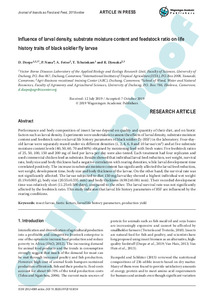| dc.contributor.author | Dzepe, D. |
| dc.contributor.author | Nana, P. |
| dc.contributor.author | Fotso Kuate, A. |
| dc.contributor.author | Tchuinkam, T. |
| dc.contributor.author | Djouaka, R. |
| dc.date.accessioned | 2022-07-22T15:29:42Z |
| dc.date.available | 2022-07-22T15:29:42Z |
| dc.date.issued | 2019-12-13 |
| dc.identifier.citation | Dzepe, D., Nana, P., Fotso Kuate, A., Tchuinkam, T. & Djouaka, R. (2019). Influence of larval density, substrate moisture content and feedstock ratio on life history traits of black soldier fly larvae. Journal of Insects as Food and Feed, 6(2), 133-140. |
| dc.identifier.issn | 2352-4588 |
| dc.identifier.uri | https://hdl.handle.net/20.500.12478/7572 |
| dc.description.abstract | Performance and body composition of insect larvae depend on quality and quantity of their diet, and on biotic factors such as larval density. Experiments were undertaken to assess the effects of larval density, substrate moisture content and feedstock ratio on larval life history parameters of black soldier fly (BSF) in the laboratory. Four-day-old larvae were separately reared under six different densities (1, 2, 4, 6, 8 and 10 larvae/cm2) and at five substrate moisture content levels (40, 50, 60, 70 and 80%) obtained by moistening feed with fresh water. Five feedstock ratios of 25, 50, 100, 150 and 200 mg of feed per larva per day were also tested. Each treatment had four replicates and used commercial chicken feed as substrate. Results showed that individual larval feed reduction, wet weight, survival rate, body size and body thickness had a negative correlation with rearing densities, while larval development time correlated positively. The increase in substrate moisture content has significantly affected the larval feed reduction, wet weight, development time, body size and body thickness of the larvae. On the other hand, the survival rate was not significantly affected. The larvae subjected to diet 150 mg/larva/day showed a highest individual wet weight (0.19±0.003 g), body size (20.55±0.335 mm) and body thickness (4.982±0.081 mm). Their recorded development time was relatively short (11.25±0.500 days), compared to the other. The larval survival rate was not significantly affected by the feedstock ratio. This study indicates that larval life history parameters of BSF are influenced by the rearing conditions. |
| dc.description.sponsorship | International Institute of Tropical Agriculture |
| dc.format.extent | 133-140 |
| dc.language.iso | en |
| dc.subject | Insecta |
| dc.subject | Larvae |
| dc.subject | Production |
| dc.subject | Yields |
| dc.subject | Feeds |
| dc.subject | Animal Feeding |
| dc.subject | Foods |
| dc.subject | Biotic Factors |
| dc.title | Influence of larval density, substrate moisture content and feedstock ratio on life history traits of black soldier fly larvae |
| dc.type | Journal Article |
| cg.contributor.crp | Agriculture for Nutrition and Health |
| cg.contributor.affiliation | University of Dschang |
| cg.contributor.affiliation | International Institute of Tropical Agriculture |
| cg.contributor.affiliation | Agri-Business Vocational Training Center, Cameroon |
| cg.coverage.region | Africa |
| cg.coverage.region | Central Africa |
| cg.coverage.country | Cameroon |
| cg.coverage.hub | Central Africa Hub |
| cg.coverage.hub | Headquarters and Western Africa Hub |
| cg.researchtheme | Nutrition and Human Health |
| cg.researchtheme | Plant Production and Health |
| cg.identifier.bibtexciteid | DZEPE:2020 |
| cg.isijournal | ISI Journal |
| cg.authorship.types | CGIAR and developing country institute |
| cg.iitasubject | Nutrition |
| cg.iitasubject | Pests of Plants |
| cg.journal | Journal of Insects as Food and Feed |
| cg.notes | Published Online: 13 Dec 2019 |
| cg.accessibilitystatus | Limited Access |
| cg.reviewstatus | Peer Review |
| cg.usagerightslicense | Copyrighted; all rights reserved |
| cg.targetaudience | Scientists |
| cg.identifier.doi | https://dx.doi.org/10.3920/jiff2019.0034 |
| cg.iitaauthor.identifier | Fotso Kuate, A.: 0000-0002-5247-7519 |
| cg.iitaauthor.identifier | Rousseau Djouaka: 0000-0003-4772-0753 |
| cg.futureupdate.required | No |
| cg.identifier.issue | 2 |
| cg.identifier.volume | 6 |

